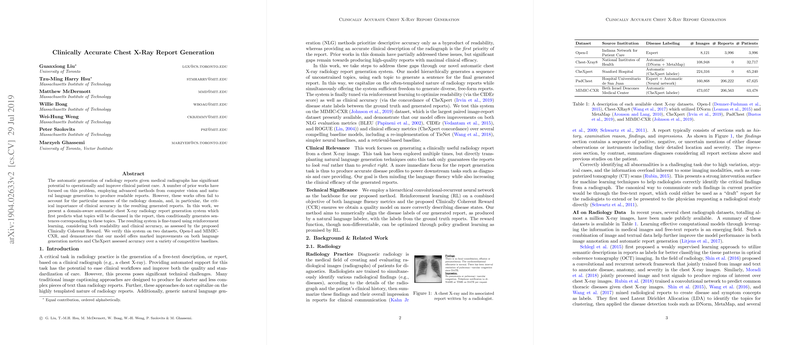Insights into Clinically Accurate Chest X-Ray Report Generation
The task of automating the generation of radiology reports from clinical radiographs, notably chest X-rays, has significant implications for enhancing efficiency and consistency in clinical environments. The paper "Clinically Accurate Chest X-Ray Report Generation" presents a model that addresses the intricate complexities specific to the radiology domain by prioritizing both readability and clinical accuracy in the auto-generation process of radiology reports.
The core of the proposed methodology lies in its hierarchical architecture, which leverages a convolutional-recurrent neural network (CNN-RNN-RNN) designed to predict report topics before generating corresponding sentences. This domain-aware approach effectively utilizes the inherently structured nature of radiology reports while maintaining the flexibility to produce varied textual outputs. The incorporation of reinforcement learning, employing a dual-objective function that optimizes both traditional language generation metrics (CIDEr) and the proposed Clinically Coherent Reward (CCR), further refines the model's performance in producing clinically relevant and fluent reports.
Model Evaluation and Performance
The model's efficacy was evaluated on two datasets, Open-I and MIMIC-CXR, where it demonstrated superiority over numerous baseline methods, including past state-of-the-art solutions such as TieNet. The metrics considered covered both language generation efficacy (BLEU, CIDEr, ROUGE) and clinical accuracy (CheXpert concordance). Noteworthy contributions of this research are the enhancements in the CheXpert-assessed accuracy, which verify the alignment of the generated reports with correct clinical annotations. The ability to generate complex reports accurately is highlighted by the model's ability to discern negative mentions in disease patterns, an area that has been complex for previous models to navigate.
Implications and Future Directions
This advancement in chest X-ray report generation has several profound practical and theoretical implications. Practically, it proposes a system capable of easing the workload of radiologists by providing draft reports that accurately encapsulate disease state information, thus enhancing clinical workflows and decision-making support. Theoretically, the work prompts further exploration into reinforcement learning within language generation contexts—particularly the efficacy of reward functions tuned to specific domain requirements.
Future developments in AI for medical applications could advance by focusing on expanding generalizability across various language and cultural contexts, thus broadening the utility of these technologies worldwide. The incorporation of multimodal data to inform the generation process holds promise for even greater clinical accuracy and nuanced understanding in the automation of radiology reports.
In conclusion, the framework detailed in this paper not only contributes to the ongoing optimization of machine learning-based report generation but also underscores the critical importance of domain-specific considerations that balance linguistic fluency with clinical authenticity. These insights pave the way for continued refinement in the deployment of AI systems within healthcare, potentially transforming the interface between diagnostics and textual representation.
